Introduction:
Steel bars, also known as reinforcement steel or rebar, are essential materials used in construction to provide added strength and durability to concrete structures. They are made from carbon steel and come in various sizes, shapes, and grades. In reinforced concrete structures, steel bars are used to resist tensile forces, which concrete cannot withstand on its own. The steel bars are placed in a grid pattern throughout the concrete structure, providing added support and resistance to bending, cracking, and breaking.
What are Steel Bars?
A steel bar is a long, solid metal rod typically made from carbon or alloy steel. It is a versatile and strong material in construction, manufacturing, and other industries. Steel bars often reinforce concrete structures to increase their strength and durability. They are also commonly used in manufacturing machinery, tools, and equipment, as well as in constructing buildings, bridges, and other infrastructure projects.
Steel bars can be made through various processes, including hot rolling, cold drawing, and extrusion. They come in various sizes, from small-diameter rods used in construction to larger, thicker bars used in heavy machinery. In addition to their strength and durability, steel bars are also valued for their corrosion resistance and ability to withstand high temperatures and pressure.
Purpose of Steel Bars:
Steel bars are commonly used in construction to strengthen and stabilize concrete structures. The primary purpose of steel bars in construction is to reinforce concrete and prevent it from cracking or breaking under stress. When concrete is used in construction, it has high compressive strength but relatively low tensile strength. It can withstand forces that push against it but can easily crack or break under forces that pull on it. Steel bars are added to concrete to provide the necessary tensile strength and help it resist forces that might cause it to fail.
Steel bars are typically placed in a grid pattern within the concrete structure to form a reinforced concrete framework. The bars are then embedded in the concrete, forming a bond between the steel and the concrete. It helps distribute the forces evenly throughout the structure, preventing any part from bearing too much weight and potentially failing. Overall, using steel bars in construction is essential to ensure the structural integrity and stability of concrete buildings, bridges, dams, and other infrastructure.
Sizes of Steel Bars for Construction Work:
The size of steel bars used for construction work depends on the specific application and requirements of the project.
The most common sizes of steel bars used in construction are:
1. 6mm diameter steel bar
2. 8mm diameter steel bar
3. 10mm diameter steel bar
4. 12mm diameter steel bar
5. 16mm diameter steel bar
6. 20mm diameter steel bar
7. 25mm diameter steel bar
These sizes are commonly used in reinforced concrete structures such as beams, columns, slabs, and foundations. The size and spacing of steel bars are specified in the structural drawings, and design calculations are based on the loads and stress the structure is expected to bear. It is important to note that these sizes are based on the metric measurement system. Steel bars may be referred to by their diameter in inches rather than millimeters in countries that use the imperial system.
Different Types of Steel Bars Used for Construction:
1. Mild Steel Bars:
These bars are completely flat and smooth, with no raised ridges. Mild steel bars can range from 6 mm to 50 mm in diameter. Hooks are required at the ends of the bars because they cannot form a strong bond with the concrete. “medium tensile steel” and “high tensile steel” describe steel with ultimate tensile strengths above 550 N/mm2 and 10000 N/mm2, respectively.
When costs need to be kept low, mild steel bars are used. The use of mild steel bars is rapidly declining as their replacement by deformed and twisted bars becomes more commonplace in the building industry. Today, expansion and contraction joints are only used in column spirals, dowels, and road and runway expansion and contraction joints.
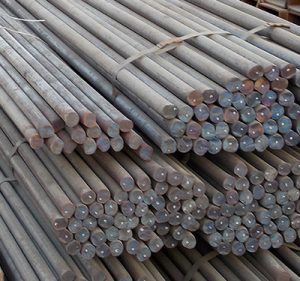
Fig 1: Mild Steel Bar
Courtesy: deepaksteelindia.com
The grades of mild steel bars used in construction are:
1. Mild Steel Grade I (Fe 410): This is the most commonly used mild steel grade for construction purposes. It has yield strength of 250 N/mm² and tensile strength of 410 N/mm².
2. Mild Steel Grade II (Fe 410): This grade is also commonly used for construction. It has yield strength of 275 N/mm² and tensile strength of 410 N/mm².
3. Mild Steel Grade III (Fe 415): This grade is used where the structure is subjected to high stresses. It has yield strength of 415 N/mm² and tensile strength of 485 N/mm².
4. Mild Steel Grade IV (Fe 500): This grade is used in areas where the structure is highly stressed, such as bridges and high-rise buildings. It has a yield strength of 500 N/mm² and tensile strength of 545 N/mm².
5. Mild Steel Grade V (Fe 550): This grade is used where the structure is subjected to extremely high stresses, such as in heavy-duty and high-rise buildings. It has yield strength of 550 N/mm² and tensile strength of 585 N/mm².
2. Carbon Steel Bars:
Carbon steel bars are commonly used in construction due to their strength and durability. They are typically made of carbon and iron and can be used for various applications, such as reinforcement in concrete, structural support, and general construction. Different grades of carbon steel bars are available, with varying levels of strength and flexibility. The most commonly used grades include ASTM A615 Grade 60 and ASTM A706 Grade 60, both high-strength reinforcement bars used in concrete construction.
Carbon steel bars are also available in different shapes and sizes, including round, square, and flat bars. The choice of shape and size depends on the specific application and requirements of the project.
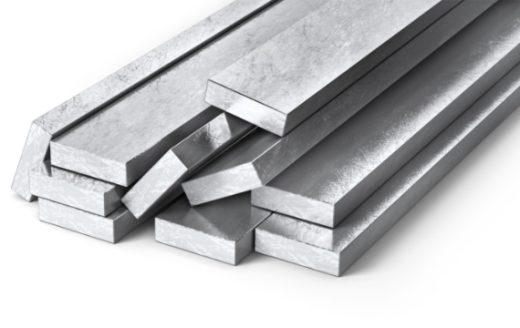
Fig 2: Carbon Steel Bar
Courtesy: yieh.com
3. Thermo Mechanically Treated Bar (TMT):
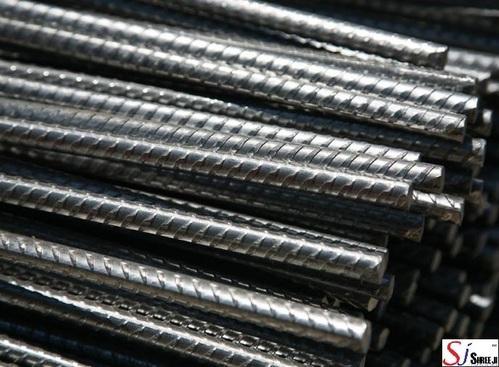
Fig 3: TMT Bar
Courtesy: shreejisteelcorp.com
It is a type of reinforcement steel bar used in construction projects. Manufacturing TMT bars involves subjecting the steel bars to a series of mechanical and thermal treatments that enhance their strength and durability. The steel bars are first hot-rolled during the production process, followed by a rapid cooling process known as quenching. This process involves passing the hot bars through water or other cooling mediums, which causes the outer surface to cool and harden rapidly. At the same time, the inner core remains hot and malleable.
After quenching, the bars are subjected to a process known as self-tempering, where they are left to cool in the open air. This process allows the inner core of the bars to gradually cool and temper, resulting in a high-strength, malleable, and corrosion-resistant material. TMT bars are preferred over traditional steel bars because they offer several advantages, including better elongation, high tensile strength, improved bonding with concrete, and resistance to corrosion and earthquakes. They are widely used in construction projects such as bridges, buildings, dams, and other structures where high strength and durability are critical.
4. Cold Rolled Steel Bar:
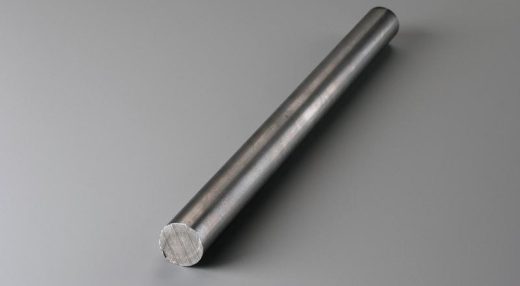
Fig 4: Cold Rolled Bar
Courtesy: coremarkmetals.com
Cold rolled steel bars are processed through a cold rolling process, which involves passing the steel through rollers at room temperature. This process results in a product with a smooth, even surface finish and tighter dimensional tolerances than hot-rolled steel bars. Cold-rolled steel bars are often used in applications where precise dimensions and a smooth surface finish are important, such as manufacturing automotive parts, machinery, and tools. The cold rolling process also increases the strength and hardness of the steel, making it suitable for use in applications that require high-strength materials.
Cold-rolled steel bars are available in a wide range of sizes and shapes, including round, square, flat, and hexagonal bars. They can also be made from various types of steel, including carbon steel, alloy steel, and stainless steel. The specific properties and characteristics of cold-rolled steel bars will depend on the type of steel used and the specific cold-rolling process employed.
5. Stainless Steel Bar:
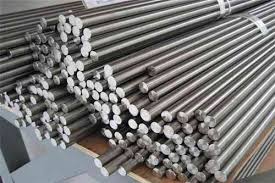
Fig 5: Stainless Steel Bar
Courtesy: jaihindmetal.in
Stainless steel bars are commonly used in construction due to their excellent corrosion resistance, strength, durability, and aesthetic appeal. They are particularly useful in areas where the bar will be exposed to harsh environments, such as high humidity or salt water. Stainless steel bars are available in various grades, shapes, and sizes, including round, square, flat, and hexagonal. The most commonly used grades for construction are 304 and 316 stainless steel. 304 stainless steel is suitable for most indoor applications, while 316 stainless steel is more appropriate for outdoor and marine applications where it will be exposed to saltwater and other corrosive elements.
When selecting a stainless steel bar for construction work, it’s important to consider the project’s specific requirements. Additionally, it’s important to ensure that the bar meets the relevant standards and regulations for the intended application.
6. Twisted Steel Bar:
Twisted or deformed steel bars are commonly used in construction work for reinforced concrete structures such as buildings, bridges, and other infrastructure. These bars have ridges or deformations on their surface, which provide better bonding between the concrete and the steel. The twisted shape also increases the tensile strength of the steel, making it more resistant to bending or breaking under load.
Twisted steel bars come in various sizes and shapes and are typically made from high-quality steel specifically designed for use in construction work. The bars are manufactured using a process known as hot rolling, which involves heating the steel to a high temperature and then passing it through a series of rollers to shape it into the desired form. After the bars are formed, they are cooled and cut to the required length.
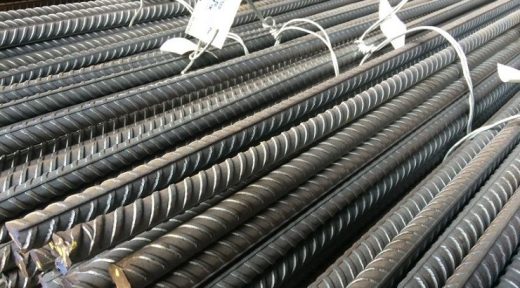
Fig 6: Twisted Steel Bar
Courtesy: constructionkenya.com
7. Welded Steel Wire:
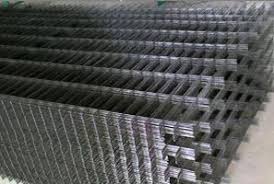
Fig 7: Welded Steel Wire Bar
Courtesy: sahariaweldmesh.com
Welded steel wire bars, also known as welded wire mesh, are often used in construction for reinforcing concrete structures. They are made from cold-drawn steel wire, which is welded together to form a grid or mesh pattern.
The welded wire mesh is typically manufactured in sheets of various sizes and thicknesses. The sheets are then cut to the desired shape and size and placed within the concrete formwork before the concrete is poured. As the concrete sets, it adheres to the mesh, providing additional strength and durability to the structure.
Welded wire mesh can be used in a variety of construction applications, including:
1. Reinforcing concrete slabs and walls
2. Creating prefabricated concrete elements such as beams and columns
3. Building retaining walls and fences
4. Reinforcing masonry walls and structures
5. Providing stability and support to slopes and embankments.
Welded wire mesh is preferred over traditional reinforcement methods such as rebar because it can be quickly and easily installed, reducing construction time and costs. Additionally, it provides constant reinforcement throughout the structure and is less prone to corrosion and other forms of damage.
Advantages of Steel Bars:
There are several advantages of using steel bars in construction:
1. Strength and Durability: Steel is a strong and durable material that can withstand high stress and pressure. It is also resistant to corrosion and can last for a long time.
2. Versatility: Steel bars can be used in various construction applications, such as building foundations, bridges, and high-rise buildings. They can also be used to reinforce concrete structures and improve their strength.
3. Ease of Use: Steel bars are easy to handle and transport, which makes them convenient for construction sites. They can also be easily cut and bent to fit the specific needs of a project.
4. Cost-Effective: Steel bars are cost-effective compared to other construction materials, especially considering their strength and durability. They require less maintenance over time, which can result in lower long-term costs.
5. Sustainability: Steel is highly sustainable as it is recyclable and can be reused for other purposes. It makes it an environmentally friendly option for construction projects.
6. Safety: Steel bars are less prone to fire and can withstand extreme temperatures, which makes them a safer option for construction projects. They also have a low risk of collapsing, reducing the risk of construction site accidents.
Disadvantages of Steel Bars:
While steel bars are commonly used in construction due to their strength and durability, there are several disadvantages to consider:
1. Corrosion: Steel bars can be susceptible to corrosion over time, especially if exposed to moisture or chemicals. Corrosion can weaken the structure and reduce its lifespan.
2. Cost: Steel bars can be expensive, especially if high-quality steel is required. Additionally, the cost of transportation and storage can add to the overall expense.
3. Weight: Steel bars are heavy, making them difficult to handle and transport. It can increase labor costs and require specialized equipment to move them around the construction site.
4. Fire risk: Steel bars are highly conductive and can transfer heat quickly, which makes them a fire hazard. It can be a concern in buildings where fire safety is a priority.
5. Environmental impact: Steel production can significantly impact the environment, including greenhouse gas emissions and pollution from manufacturing processes.
Conclusion:
Steel bars are critical in construction due to their strength, durability, and versatility. They are widely used in various construction projects, such as building foundations, bridges, highways, and tunnels. Steel bars provide a high tensile strength necessary for withstanding construction’s heavy loads and stresses. Moreover, steel bars can be easily fabricated and shaped to meet the specific requirements of each construction project. They are also resistant to corrosion and fire, making them a reliable and safe choice for construction purposes.
References:
1. 6 Factors of Choosing the Best Steel Bar for Construction – ARS Steels. (2022, October 17). 6 Factors of Choosing the Best Steel Bar for Construction – ARS Steels. https://arsgroup.in/blog/choose-the-best-steel-bar-for-construction.html
2. Shaikh, S. (2022, September 2). 6 Types of Steel Bars Used In Construction. Easy Interio. https://easyinterio.com/types-of-steel-bars-used-in-construction/
3. Types Of Steel Bars For Construction | Reinforcing Steel Types. (n.d.). Types of Steel Bars for Construction | Reinforcing Steel Types. https://www.constructioncost.co/steel-bars-for-construction.html
4. Visions, P. (2021, January 4). Different types of steel bars used in construction./ Various types of reinforcement bars./Classification of rebars in civil engineering. Different Types of Steel Bars Used in Construction./ Various Types of Reinforcement Bars./Classification of Rebars in Civil Engineering. ~ PARAM VISIONS. https://www.paramvisions.com/2021/01/different-types-of-steel-bars-used-in.html
5. List of 5 Different Types of Steel Bars Used in Construction | Sugna TMT. (2021, June 13). List of 5 Different Types of Steel Bars Used in Construction | Sugna TMT. https://sugnatmt.com/types-of-steel-bars-in-construction/
6. S. (2017, June 20). TYPES OF STEEL BARS. TYPES OF STEEL BARS | CIVIL ENGINEERING. https://knowledge4civil.wordpress.com/2017/06/20/types-of-steel-bars/
If you have a query, you can ask a question here.



What is difference between TMT and twisted steel bar